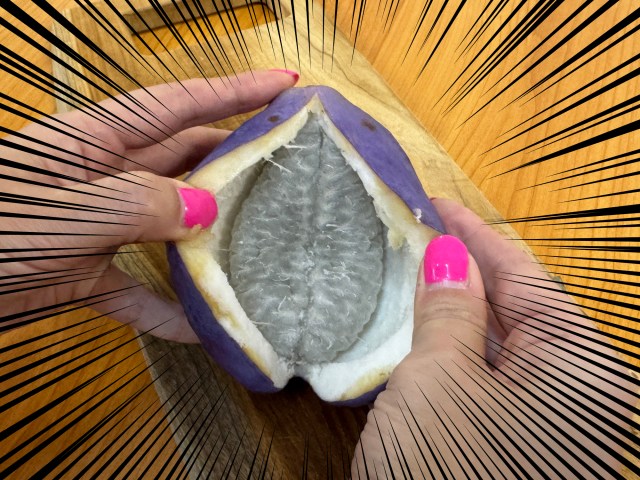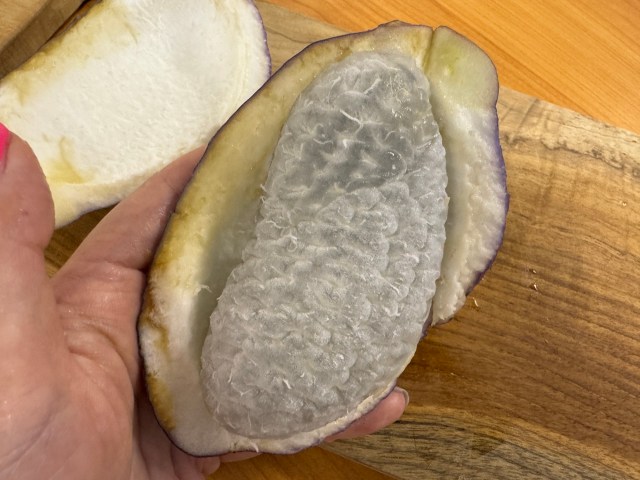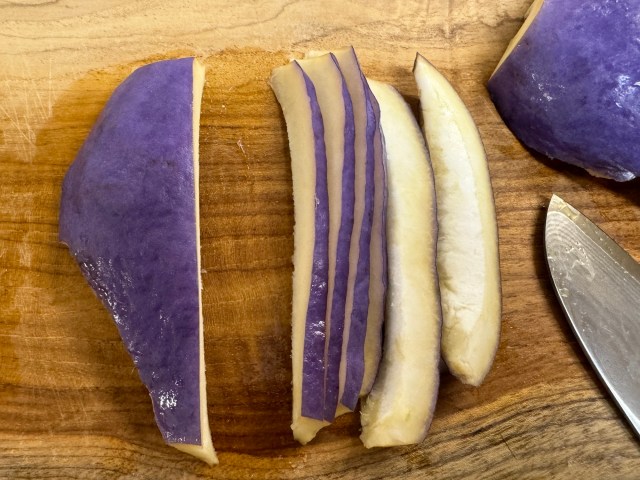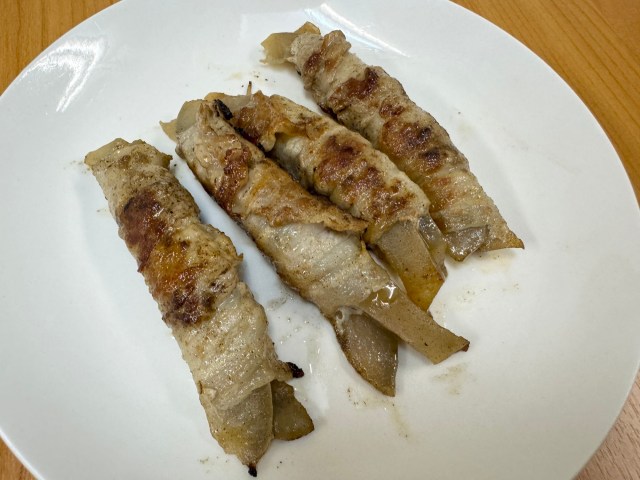
We make a simple dish with the fruit that would make Crayola proud by cooking it with…pork?!
“What the heck is that?!” thought our Japanese-language reporter Ikuna Kamezawa when she first laid eyes on the odd-looking fruit of the five-leaf chocolate vine shrub (akebia quintana), called akebi in Japanese. She’d known of its existence since she was a child but had never consciously encountered one until the produce section 0f this Ozeki supermarket in Tokyo. Its actual appearance was so far off from what she had imagined that she immediately messaged a friend to confirm that she wasn’t just imagining things.
Akebi are generally in season during the short window from October through November every year. It was hard for Ikuna to believe that such a deep purple fruit even grew in Japan in the first place (this particular one was from “Fruits Kingdom” Yamagata Prefecture). In fact, the outer coloring was so vivid that it gave the appearance of being some kind of poisonous plant or a strange, power-granting Devil Fruit hybrid from One Piece.
▼ One akebi cost 430 yen (US$2.88) at Ozeki, but she had no idea if this price was reasonable since it was her first time buying one.
There was a small sign next to the supermarket display recommending two delicious ways of preparing it–either by wrapping the sliced fruit with grilled pork ribs, or by stir-frying it with a miso seasoning. Ikuna had no idea if these prep ideas were supposed to be common knowledge in Japan, but in any case, she couldn’t NOT try one of them for herself at this point.
Once home and in her kitchen, Ikuna looked up the proper way to cut an akebi online. There would be a pulp surrounded by a thicker skin, so she cautiously made a lengthwise slit into the fruit.
WHOAH! This cross-section was not what she was expecting at all. She let out an audible gasp.
As a visual kei fan, Ikuna compared the appearance of the fruit’s fleshy pulp to something that she might see in a macabre Dir En Grey music video. It also gave off the vibe of an alien species about to be born from an unusual egg sack. She might actually die of shock if it were to suddenly start moving.
She called a coworker over for emotional support before slowly inserting her spoon into the pulpy part…
…and then recoiled in horror at what slowly oozed out.
▼ She had so much respect for the first person that had decided it was a good idea to eat this.
There was no going back now, though. Taking a deep breath, she prodded at the opening and more and more of the fruit seeds encased in a jelly-like protective substance spilled out. They clearly resembled frog eggs.
Taking a deep breath, she raised the spoon to her mouth and took a bite.
All her fears were pushed to the side because WOW–akebi pulp was delicious! It had the same kind of texture and sweetness as the mochi in a high-grade yukimi daifuku along with the freshness that only fruit can offer. The seeds, which aren’t generally supposed to be eaten, were the only drawback. But while she had imagined that the taste would be a bit more polarizing, it seemed liked something that most people would generally like.
▼ Ikuna: “Sorry, akebi pulp, for not realizing sooner how great you are!”
On the other hand, she hadn’t yet tried the firmer skin part, which is said to be slightly bitter. Most people apparently cook it in some way in order to reduce that taste. She therefore removed the center pulp and sliced the skin into appropriately thick chunks before dropping it into a pot and letting it come to a boil.
After boiling, it needed to soak in cold water for a long time to further reduce the bitterness. Ikuna left it this way for three hours.
Next, since she had decided to follow Ozeki’s recipe for the akebi wrapped in sliced pork rib, she prepared all of the necessary items.
The recipe was quite simple because all she had to do was wrap a couple slices of fruit with the rib and sprinkle them generously with salt and pepper. It was at this point that she noticed that the outermost layer of skin had already lost most of its vibrant purple color.
She cooked them over the stove for a while and then let them steam for a bit.
Here was the finished product!
She thought that they looked pretty darn delectable. She couldn’t wait to pop one into her mouth.
It was good–reasonably good. However, there was no denying that the true standout part of the dish was the seasoned pork. In contrast to that, the akebi lacked a large presence in terms of taste and texture. If Ikuna had to compare it to something, she thought it was kind of like a potato but with 10 times less presence. There was no strong flavor, no chewiness, and just a slight bitterness remaining (which may or may not have been her own fault as an inexperienced akebi cook). She settled on the following description of the fruit in this form: “It’s a bulking ingredient with no flavor.”
However, her fellow writer Takamichi just happened to be in the office at that time, so she let him try it, too. He thought it was absolutely delicious and that the slight bitterness could easily become addicting. Ultimately, it seems that everyone’s preference is just a little bit different.
Since the season to try akebi is so limited, you might want to look for one sooner rather than later if you’re in Japan around this time. While you’re at it, try looking for some other slightly more unusual fall fruits as well.
All images © SoraNews24
● Want to hear about SoraNews24’s latest articles as soon as they’re published? Follow us on Facebook and Twitter!
[ Read in Japanese ]


















 10 times to avoid traveling in Japan in 2026
10 times to avoid traveling in Japan in 2026 Our 52-year-old pole dancing reporter shares his tips for achieving your New Year’s exercise goal
Our 52-year-old pole dancing reporter shares his tips for achieving your New Year’s exercise goal We ate sushi made from Japan’s most expensive tuna ever【Taste test】
We ate sushi made from Japan’s most expensive tuna ever【Taste test】 Say hello to Japan’s new stationmaster cat!【Video】
Say hello to Japan’s new stationmaster cat!【Video】 Princess Mononoke magnets return just in time to treat yourself to awesome anime decorations
Princess Mononoke magnets return just in time to treat yourself to awesome anime decorations 10 times to avoid traveling in Japan in 2026
10 times to avoid traveling in Japan in 2026 Our 52-year-old pole dancing reporter shares his tips for achieving your New Year’s exercise goal
Our 52-year-old pole dancing reporter shares his tips for achieving your New Year’s exercise goal We ate sushi made from Japan’s most expensive tuna ever【Taste test】
We ate sushi made from Japan’s most expensive tuna ever【Taste test】 Say hello to Japan’s new stationmaster cat!【Video】
Say hello to Japan’s new stationmaster cat!【Video】 Princess Mononoke magnets return just in time to treat yourself to awesome anime decorations
Princess Mononoke magnets return just in time to treat yourself to awesome anime decorations Umamusume anime girl plushie recalled for having parts she absolutely should not have【Pics】
Umamusume anime girl plushie recalled for having parts she absolutely should not have【Pics】 Toyota built a life-sized Miraidon Pokémon and are letting people test drive it this weekend
Toyota built a life-sized Miraidon Pokémon and are letting people test drive it this weekend Japanese avoiding domestic travel as foreign tourists increase, possibly creating vicious cycle
Japanese avoiding domestic travel as foreign tourists increase, possibly creating vicious cycle The Purple Lucky Bag from Village Vanguard is an extra-large waste of money
The Purple Lucky Bag from Village Vanguard is an extra-large waste of money We stress-test Uniqlo’s “Impressive Jacket and Pants” to see if they live up to their names
We stress-test Uniqlo’s “Impressive Jacket and Pants” to see if they live up to their names Japanese beef bowl chain Sukiya’s 2026 Smile Box lucky bag basically pays for itself
Japanese beef bowl chain Sukiya’s 2026 Smile Box lucky bag basically pays for itself Hayao Miyazaki says Happy New Year to Studio Ghibli fans with new art for Year of the Horse
Hayao Miyazaki says Happy New Year to Studio Ghibli fans with new art for Year of the Horse Ramen restaurant’s English menu prices are nearly double its Japanese ones, denies discriminating
Ramen restaurant’s English menu prices are nearly double its Japanese ones, denies discriminating Starbucks Japan ready to get Year of the Horse started with adorable drinkware and plushies【Pics】
Starbucks Japan ready to get Year of the Horse started with adorable drinkware and plushies【Pics】 Top Japanese cosplayer Enako returns to Comiket after 6 years, creates mayhem with admirers
Top Japanese cosplayer Enako returns to Comiket after 6 years, creates mayhem with admirers Cup Noodle tries an authentic Jiro-style ramen, but something’s not quite right
Cup Noodle tries an authentic Jiro-style ramen, but something’s not quite right The best Starbucks Japan Frappuccinos we want to drink again in 2026
The best Starbucks Japan Frappuccinos we want to drink again in 2026 We revisited Sweets Paradise after a decade to see if Japan’s dessert buffet still delivers
We revisited Sweets Paradise after a decade to see if Japan’s dessert buffet still delivers That time Seiji called JASRAC to ask why he didn’t get paid royalties for his song being on TV
That time Seiji called JASRAC to ask why he didn’t get paid royalties for his song being on TV 7-Eleven Japan starts new temporary luggage storage service in over 300 branches
7-Eleven Japan starts new temporary luggage storage service in over 300 branches Disillusionment at Tsukiji’s tourist-target prices led us to a great ramen restaurant in Tokyo
Disillusionment at Tsukiji’s tourist-target prices led us to a great ramen restaurant in Tokyo Starbucks teams up with 166-year-old Kyoto doll maker for Year of the Horse decorations【Photos】
Starbucks teams up with 166-year-old Kyoto doll maker for Year of the Horse decorations【Photos】 Tokyo considering law requiring more trash cans following litter increase in heavily touristed area
Tokyo considering law requiring more trash cans following litter increase in heavily touristed area Tokyo’s Tsukiji sushi neighborhood asks tour groups to stay away for the rest of the month
Tokyo’s Tsukiji sushi neighborhood asks tour groups to stay away for the rest of the month Tokyo event lets you travel back in time, for free, to celebrate 100 years since Showa era start
Tokyo event lets you travel back in time, for free, to celebrate 100 years since Showa era start Japan may add Japanese language proficiency, lifestyle classes to permanent foreign resident requirements
Japan may add Japanese language proficiency, lifestyle classes to permanent foreign resident requirements Lacquerware supplier to emperor of Japan and Pokémon team up for new tableware
Lacquerware supplier to emperor of Japan and Pokémon team up for new tableware Starbucks Japan releases new zodiac chilled cup drink for 2026
Starbucks Japan releases new zodiac chilled cup drink for 2026 Survey asks foreign tourists what bothered them in Japan, more than half gave same answer
Survey asks foreign tourists what bothered them in Japan, more than half gave same answer Japan’s human washing machines will go on sale to general public, demos to be held in Tokyo
Japan’s human washing machines will go on sale to general public, demos to be held in Tokyo We deeply regret going into this tunnel on our walk in the mountains of Japan
We deeply regret going into this tunnel on our walk in the mountains of Japan Studio Ghibli releases Kodama forest spirits from Princess Mononoke to light up your home
Studio Ghibli releases Kodama forest spirits from Princess Mononoke to light up your home Major Japanese hotel chain says reservations via overseas booking sites may not be valid
Major Japanese hotel chain says reservations via overseas booking sites may not be valid Put sesame oil in your coffee? Japanese maker says it’s the best way to start your day【Taste test】
Put sesame oil in your coffee? Japanese maker says it’s the best way to start your day【Taste test】 No more using real katana for tourism activities, Japan’s National Police Agency says
No more using real katana for tourism activities, Japan’s National Police Agency says Starbucks Japan reveals new sakura drinkware collection, inspired by evening cherry blossoms
Starbucks Japan reveals new sakura drinkware collection, inspired by evening cherry blossoms Updated cherry blossom forecast shows extra-long sakura season for Japan this year
Updated cherry blossom forecast shows extra-long sakura season for Japan this year Human washing machine pods coming to Japanese hotels【Photos】
Human washing machine pods coming to Japanese hotels【Photos】 Umamusume anime girl plushie recalled for having parts she absolutely should not have【Pics】
Umamusume anime girl plushie recalled for having parts she absolutely should not have【Pics】 Toyota built a life-sized Miraidon Pokémon and are letting people test drive it this weekend
Toyota built a life-sized Miraidon Pokémon and are letting people test drive it this weekend Japanese avoiding domestic travel as foreign tourists increase, possibly creating vicious cycle
Japanese avoiding domestic travel as foreign tourists increase, possibly creating vicious cycle The Purple Lucky Bag from Village Vanguard is an extra-large waste of money
The Purple Lucky Bag from Village Vanguard is an extra-large waste of money We stress-test Uniqlo’s “Impressive Jacket and Pants” to see if they live up to their names
We stress-test Uniqlo’s “Impressive Jacket and Pants” to see if they live up to their names Play with fire at an old-fashioned “irori” hearth restaurant
Play with fire at an old-fashioned “irori” hearth restaurant Rakuten randomly offers 58 New Year’s osechi feasts in Japan, but did we get a star or a dud?
Rakuten randomly offers 58 New Year’s osechi feasts in Japan, but did we get a star or a dud? You can now visit a recreation of Evangelion’s Tokyo-3 and live there in miniature form in【Pics】
You can now visit a recreation of Evangelion’s Tokyo-3 and live there in miniature form in【Pics】 Life-size Nier: Automata sword going on sale, includes 2B’s voice if you swing it the right way
Life-size Nier: Automata sword going on sale, includes 2B’s voice if you swing it the right way Stunning 22-year-old HD footage brings Tokyo of the ‘90s back to life
Stunning 22-year-old HD footage brings Tokyo of the ‘90s back to life Disillusionment at Tsukiji’s tourist-target prices led us to a great ramen restaurant in Tokyo
Disillusionment at Tsukiji’s tourist-target prices led us to a great ramen restaurant in Tokyo We have some welcome and not-so-welcome visitors at our cheap house in the countryside【SoraHouse】
We have some welcome and not-so-welcome visitors at our cheap house in the countryside【SoraHouse】 Studio Ghibli now sells plush toys seen on Howl’s bed from Howl’s Moving Castle
Studio Ghibli now sells plush toys seen on Howl’s bed from Howl’s Moving Castle
Leave a Reply